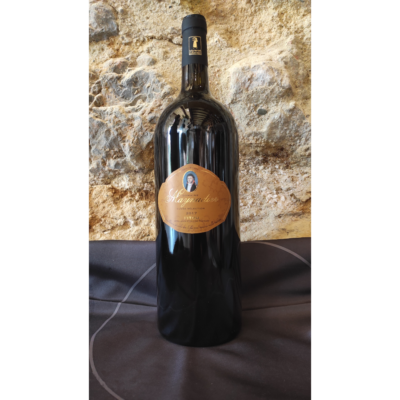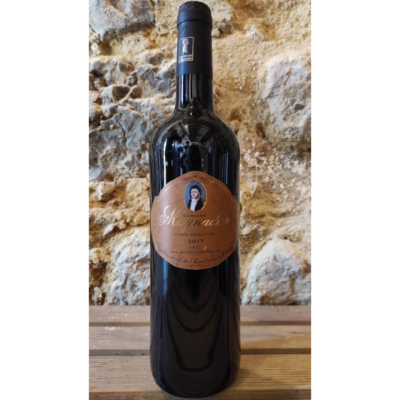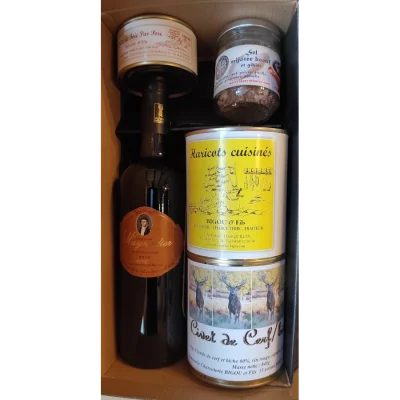Prehistory and Roman period
More than a million years ago, the first men arrived here, as attested by the first bifaces (archaic stone tools) found in the region on the alluvial terraces of the Agly (see Jean Abélanet’s work). At the same time, under the pressure of the Günz glaciation, enormous masses of alluvium were deposited at the end of the valleys, forming a large part of the soil of our vineyards (which are therefore a million years old!).
At that time, man lived as a nomad following the game (rhinoceros, bison, horses, aurochs) in a steppe setting, alternately occupying caves or open-air camps depending on the temperature variations. About ten thousand years ago the climate finally warmed up. The first villages appeared and man settled down only five to seven thousand years ago. Indeed, the beginnings of animal husbandry and agriculture (thanks to cereals and domestic animals imported from the Near East) no longer imposed nomadism as a way of life.
Two sites very close to Fitou (Cova de l’esperit cave in Salses and Correge peninsula in Leucate) show us that at that time the forest was largely dominant, rabbits and wild boars were already hunted there, as well as wild ox and ibex, and mussels and sea bream were caught. This Neolithic fishing village, situated on a hill between two branches of the Agly river, is now drowned under 5 metres of water!
Pottery, stone or bone tools, millstones, remains of goats, sheep, oxen and pigs show how similar these early Aude farmers were to us.
In the commune of Fitou there were also remarkable sites: a Bronze Age necropolis found at Le Pla dating from less than 400 BC and at the place known as Les Arques a chest tomb also dating from this period. It was in fact 950 BC that the practice of cremating bodies and burying funeral urns spread to our regions.
The first iron tools (-750 BC) appeared during this period of rapid population growth, accompanied by the construction of fortified places (oppida) wherever possible. The first stones of the Château de Fitou probably date from this period.
Celts, Iberians, Etruscans, Greeks mixed with the peoples already present: Elysians, Sordes, Debryces, Ceretans…
Warehouses and trading posts line the coast. Fitou is on the route of what was to become the first road built by the Romans in Gaul, the Via Domitia, named after its designer, Cneus Domitius Ahenobarbus in 118 BC. The purpose of this Domitian road was to link Italy to the Iberian Peninsula by crossing Narbonne Gaul. It allowed the installation and circulation of Roman garrisons and Narbo Martius – Narbonne – became the most important city in southern Gaul.
Fitou is therefore located in a strategic place where commercial, military and administrative exchanges are considerable. The precise route of the road is controversial but a military milestone was discovered on the Pla, 2 kilometres west of the village. It could justify the Roman etymology of Fitou which would be “fita”, the limit or the milestone.
The vine, already
The southern vineyards gradually became established until they became indispensable, and the Emperor Augustus did much for their development by exporting them to Italy. Later, in 79 AD, the eruption of Vesuvius, which destroyed the town of Pompeii and its vineyards, further accelerated this development.
The shores of the Mediterranean were then colonised by the Romans, the Pax Romana reigned and the region prospered. Unfortunately, barbarian invasions endangered these cultures and the various conflicts made the region very unstable for several centuries.

Septimania
In 419, Septimania was born, encompassing the departments of Pyrénées Orientales, Aude, Gard and Hérault. The Romance language of Oc was spoken there, which gave the province Languedoc its name in the 13th century.
Narbonne and its surroundings were the object of successive conquests: Gondebaud, king of the Burgundians, the Goths, the Visigoths, Childebert I (son of Clovis, king of Paris), again the Visigoths, the Saracens…
In the meantime, in 582 and again in 584, the plague ravaged the region. In 720, the Saracens introduced leprosy, which did not disappear completely until 1624. Fitou was used as a leprosarium, installed in the place of the old Roman hospital and which later became the Saint Aubin chapel.
In 732, Charles Martel repelled the Saracens. In 739, Septimania submitted to Pepin, then Charlemagne.
990, first written mention of Fitou, in reference to its castle.
The first written mention of Fitou is found in the will of Adelaide, Viscountess of Narbonne, in 990. She bequeathed her castle “in vila de Fictorius” to Ermengaud de Narbonne. No one knows when the castle was built, but it is known that it is located on a territory of more than 3000 hectares.
Traces of the castle can be found in 1271, when Viscount Aymeric of Narbonne and his brother Almaric mention it. They claim to hold the castrum, a fortified place, from the king. However, the lords and their heirs were only vassals of the Pérignan family, which had full seigniorial rights over Fitou and its region. The territory of the castle extends at this period to the border of Salses. The Pérignan family also exercised justice on its territory.
In these troubled times, the castle had a succession of occupants as a result of the wars during which it was besieged, burnt, destroyed and rebuilt many times.
In 1635, Richelieu declared war on Spain. The Spaniards took the castle, lost it and took it back in 1639. It was not until 1659, with the signing of the Treaty of the Pyrenees and the return of peace, that the castle of Fitou and its village enjoyed a little respite.
The lord of Fitou is traced back to 1674, a descendant of the Pérignan family, Amauri. We then know the name of the last seigneury that occupied it before the French revolution of 1789, the Aragon family.

The abandonment and demolition of Fitou Castle.
With no tenants, the castle fell into disrepair after the revolution, to the point of being considered an “unoccupied hovel” in a report of 1807. It was later destroyed by fire and ordered to be demolished in 1841. The dismantling followed with the beams used for the presbytery and the villagers took charge of “recovering” the rest.
The castle has since been restored and is used as a restaurant, museum and nightclub.
The return of the vine
In the 19th century, the climate in the region was similar to that of today. The winters were harsh, the wind beat relentlessly across the countryside in both summer and winter, and cereal and olive cultivation suffered. Vines, on the other hand, adapted very well to this climate and to the unpleasant soil.
The inhabitants of Fitou adapted and made a living from the cultivation of vines, livestock and small-scale industry. There are numerous traces of sheepfolds, called courtals, which testify to the development of goat and sheep farming.
In terms of industry, plaster quarries flourish here and there. These quarries, from which gypsum – the stone used for plaster – is extracted, supply the lime kilns of the Cabanes de Fitou, which process the raw material that arrives by mule. Three lime kilns and a plaster mill were recorded in 1868 and, in 1881, the lime factory was built at La Madeleine, which benefited from the proximity of the railway to distribute its production. Its closure in 1951 led to the disappearance of the station, due to the lack of sufficient rail traffic.

The wars of the 20th century
The Fitounais were not spared by the “Der des Ders” and twenty-four of them did not return from the distant front. Among the survivors, many were wounded or sick.
During the Second World War, Fitou was occupied by the Germans and the commune was used to store artillery pieces in the bunkers built by the support company stationed in the village. Remains of the bunkers can still be seen at the exit of the village, on the left of the Chemin de Vigné, on the hill of Pédros and on the peninsula.
Fitou AOC
In 1933, thanks to a group of owners, a Cooperative Society of Wine-making and Mistelles was created in the commune of Fitou and it was in 1948 that the Fitou Appellation d’Origine Contrôlée was officially created by decree.




